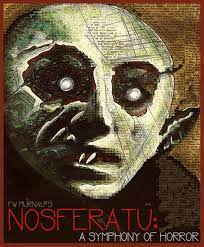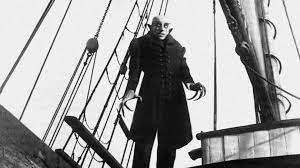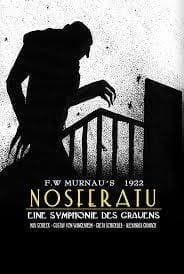
Long elastic bones, a black coat overpowering his figure, and claws for fingernails. Rings a bell? Nearly all horror movies still follow the same lineup to some extent. That is the charm and respect curtailed to Nosferatu. A movie that has inspired musicians, designers, filmmakers, and more. From a visual gag in an episode of SpongeBob Squarepants, as a video game – Red Dead Redemption 2 and as a fashion theme- the Nosferatu Chic collection by Dutch fashion designers Viktor and Rolf was showcased in Paris this year. It’s an idea that doesn’t die, even 100 years later.
The title of the movie itself sends you right into the world of darkness. It’s telling you exactly what the movie has to offer, an elaborate horror composition, meant to disrupt all concepts of right and wrong.
Based on the novel ‘Dracula’ by Bram Stoker, it is directed by F. W. Murnau with the costumes and sets handled by Albin Grau and photography curtailed by S.A. Wagner.
Doesn’t the beginning remind you of movies and chronicles that end in harmony, the estranged lover finally getting the woman of her dreams, or of a saga that has a happy ending? A couple, Thomas and Ellen, living in a small town (hello, isn’t this how all romance movies start?), but wickedly paired with a contrasting thought, the beginning and the end of the Great Death in their hometown, Wisborg.

As the movie begins, we see Hutter, getting ready in a minimalistic room while Ellen bonds with her cat. Hutter handpicks a few flowers for his wife. The two fall into each other’s arms as if meeting after years of separation and suggesting pure marital bliss. As Hutter hands over the flowers to Ellen in their drawing room, the first sign of misdirection towards the audience pops off. “Why have you killed them… the beautiful flowers?!”, Ellen asks as if the flowers had more value than Hutter’s love for her.
As Hutter leaves the house, an old man stumbles upon him, and says, “Do not hurry my young friend! Nobody can escape his destiny.” A subtle foreshadowing of what might happen inevitably.
A real estate agent who goes by the name Knock (ironic), laughs viciously as he reads something on a piece of paper. His hair looks like it hasn’t been combed in days and a smile that might scare even the bravest. He read something so wicked, that he has to string himself back to reality. A plan, an idea, or a thought? Who knows! When Hutter enters Knock’s office and tells him about a new prospect, the tune in the background suddenly shifts from a melody to that of a tragic connotation. It entirely shifts the perspective of the audience that what was normal has turned absurd, what was peaceful has turned harmful and what was life has turned into death.
‘A deserted house’, Knock mentions to Hutter, and what good ever comes out of a house that is lonesome in its standing? Hutter seems more than ecstatic to go visit the country of ghosts and thieves as if it is his calling in life whereas Ellen seems distraught, which propels us to think, does she know more? Has she hidden something from her husband? Does she worry her husband will ever return? Does the marital bliss end here? The film poses a lot of questions and doubts, but whether it answers them, will be discovered only later.
The Hutter abandoning his wife sequence also shows the difference in their personalities. Ellen feels terrified and meek whereas Hutter seems athletic and piercing while leaving.
The shock everyone displays when hearing Count Orlok castle’s mention shows there is a revelation beyond our imagination to be unearthed and builds suspense to draw the audience in. The use of eyes in emoting and expressing is a direct German Expressionism tactic, one used beautifully throughout this movie.
Capturing animals a hundred years ago in the wild would have been difficult, but nothing the German directors couldn’t furnish. The interiors of any housing haven’t gone under any beautification. They are simplistic, minimalistic, and unhindered. The fact that nothing stands out is what stands out.
When Hutter laughs off the story in the book he finds in his room, the audience is subtly told he will soon have a taste of his negligent attitude.

The background score fills the screen with intensity when the sun is going down. People fear the night more than they prefer to make wages or complete their chores. The acceptance to ride the carriage of a man who has covered his horses in a black shade cloth as well as himself, with only his eyes expressing the world, shows Hutter’s willingness to meet Count Orlok.
What’s amusing is the narrative shift this film contains. Our mind has been trained that it’s the vulture that knocks at the prey’s home, not the other way round. But in the movie, we see the human quite wilfully going to the vampire and into a world of horrors and nightmares, a world that will be hard coming back from. The opening and closing of doors at Orlon’s mansion does shake him, but not enough to turn back and leave. Nor does the creepy tall man appear before him, showcasing chivalry. But at what cost?
The sudden zoom on faces, the out of sorts hairy eyebrows, the skeleton on the clock, all suggest something. All this imagery is used to invite the audience into the world of death, horror, and wickedness. When Hutter mistakenly bruises himself with a knife, one can almost see the fear building in his body, something that didn’t exist before this, people’s theories about Count Orlok were about to be tested and he was the experiment.
Hutter checking his neck for any sign of a vampire bite and the smile that follows gives us an insight into how people can influence you to believe anything, even for a person as erect as Hutter. This shot encapsulates everything German expressionism doesn’t stand for. Beautiful landscape, structure, and aesthetic, but still fits exceptionally into the movie.
When a picture of Hutter’s wife, Ellen, slips out from his belongings, it catches the eye of Count Orlok. He picks it up, stares at it for a good few seconds, and then smells it. All this while, Hutter stands in a timid shock. “Your wife has a beautiful neck”, Orlok says, which yet again completely shatters Hutter’s and the audience’s perception, that this castle and moreover its owner was safe. Not a moment later, Orlok agrees to buy the house that is right opposite Hutter’s, suggesting his intentions have changed. For what reason? Could be the property or Ellen’s beautiful neck. But this demands the question, why did Count Orlok not kill Thomas any chance he got?
We see Hutter turning a page of the vampire book every few shots, just how the story is unfolding revealing one thing at a time, keeping the audience hooked and inquisitive. Whenever the shots need to show urgency, the corners are blurred out to give focus to a certain person or thing. This happens throughout the movie.
When Orlok comes to kill Hutter, he is distracted by a calling, a calling coming from Ellen miles away. The entire sequence communicated the essence beautifully through editing by showing two parallels at the same time. Scavengers like fingers, vampire teeth, pointed long nose, ears like that of an elephant, laying in a casket in his deep sleep. All of Hutter’s fears about Orlok had come true.
The angle of Professor Bulwer telling his students about meat-eating plants is the perfect juxtaposition reflecting the vampires living on human blood. The film has done an absolutely fantastic job in capturing and portraying minute details such as the spiders on their webs and the plant devouring an insect. The use of symmetry, rounded entrances, and curvatures depicting misc-en-scené is also a central aesthetic in the film.
To pull off showing shadows such as above back in the 1920s is something only the Germans could have pulled off. This could easily be the first attempt at showing a ghostly figure and thus inventing the horror genre, jump scares, and ghostly shadows in the horror films to follow.
Knock’s painting of Orlok foreshadows what’s coming. Showing how the compartment on the ship open back in 1922 must have been extremely difficult, as there were no green screens then. With every passing second, the shot changes, creating a visually appealing sequence. The curves and arches of any entrance or door are almost made to fit the frame of Count Orlok’s distinct and absurd bat-shaped facial structure.
Another beautiful shot of an entrance, the arcs in the doors are yet another feature spread throughout the movie. There is literally no boring door/entrance to be seen in the movie. The appearing and disappearing shots are another attraction and must have baffled the audiences in confusion and applause. Showing moving sunlight on the ceiling of the boat, right above the man here, experimenting with various techniques to depict reality as accurately as possible.
Both these shots are taken from a different kind of setting. Where one is a wide-angle shot, the other one from a higher angle, yet again giving a new perspective to the audience to witness and grasp the film playing out.
Nosferatu is one of the initial movies to use shadow work as an instrument of instigating horror and fear in the audience. This technique has been widely used in the last 100 years, but this film is where the idea was constitutionalized. While the first film defining the German Expressionist era, The Cabinet of Dr. Calligari was shot indoors, Nosferatu was mostly stationed outdoors.
The film culminates in coming across as a man cursed to be a vampire freed only if the jinx is uplifted by another.
The essence of any horror movie or the entire genre in the last couple of decades has been background music. Based on my own experience and a couple of theories, if you watch a horror movie on mute, you won’t be as scared with the volume on full. From jump scares to eerie music playing, horror movies use such techniques to scare the audiences. But back in the 1920s, nothing of this sort used to exist. Still so, people were scared beyond the limits of the movies pertaining to the early films of the German Expressionist era. Even though the evolution of humans and the advent of technology has made us come far, watching a 100-year-old movie, exceptionally executing the disappearing and reappearing of the vampire, blending in flawlessly with the setup or the opening or closing of doors with no one present around, is a sight for the eyes and an awe factor for any cinema enthusiast.
About the Author: Mahua Jaiswal is a first-year master’s student at Manipal Institute of Communication, MAHE.

Be the first to comment